
Myanmar operates de jure as a unitary assembly-independent presidential republic under its 2008 constitution. On 1 February 2021, Myanmar's military took over the government in a coup, causing ongoing anti-coup protests.
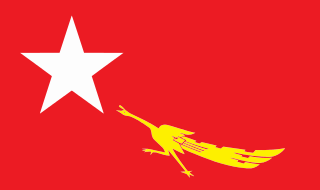
The National League for Democracy is a deregistered liberal democratic political party in Myanmar (Burma). It became the country's ruling party after a landslide victory in the 2015 general election but was overthrown in a military coup d'état in February 2021 following another landslide election victory in 2020.

Myanmar is a unitary republic, with elected representatives at the national state or region levels. On the national level, the president who is the head of state and legislature, is elected indirectly through an Electoral College. According to the 2008 constitution, the term durations of the President, and Cabinet are five years. All elections are regulated by the Union Election Commission.
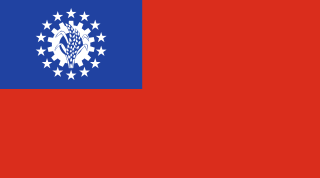
The State Peace and Development Council was the official name of the military government of Burma (Myanmar) which, in 1997, succeeded the State Law and Order Restoration Council that had seized power under the rule of Saw Maung in 1988. On 30 March 2011, Senior General and Council Chairman Than Shwe signed a decree that officially dissolved the council.
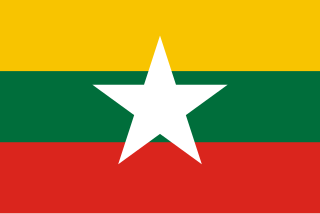
The National Coalition Government of the Union of Burma was an administration which claimed to be the government in exile of Burma (Myanmar). It had its headquarters in Rockville, Maryland, United States. It was formally established in December 1990, with Sein Win as its first prime minister. It was dissolved in September 2012.

The State Seal of the Republic of the Union of Myanmar is the national emblem used in all official government documents, including publications. As the seal is an official symbol, there are State Seal Law and Principles regarding appropriate usage of it.

General elections were held in Myanmar on 27 May 1990, the first multi-party elections since 1960, after which the country had been ruled by a military dictatorship. The elections were for a parliament-sized constitutional committee to draft a new constitution.

The president of the Republic of the Union of Myanmar is the head of state and constitutional head of government of Myanmar. The president chairs the National Defence and Security Council and normally leads the Cabinet of Myanmar, the executive branch of the Burmese government, though the military prime minister leads the cabinet under the current state of emergency. The current president is Myint Swe, who assumed the presidency through a military coup d'état on 1 February 2021. Though a constitutionally powerful position, the presidency is a largely symbolic post under the current military government, with Myint Swe appearing only to rubber-stamp military rule.

General elections were held in Myanmar on 7 November 2010, in accordance with the new constitution, which was approved in a referendum held in May 2008. The election date was announced by the State Peace and Development Council (SPDC) on 13 August.

A constitutional referendum was held in Myanmar on 10 May 2008 according to an announcement by the State Peace and Development Council in February 2008. According to the military government, the new Constitution of Myanmar will ensure the creation of a "discipline-flourishing democracy". Multi-party elections followed in 2010.

The Constitution of the Republic of the Union of Myanmar is the supreme law of Myanmar. Myanmar's first constitution adopted by constituent assembly was enacted for the Union of Burma in 1947. After the 1962 Burmese coup d'état, a second constitution was enacted in 1974. The country has been ruled by military juntas for most of its history.

The vice-presidents of Myanmar are the second highest-ranking posts in the government of the Republic of the Union of Myanmar. The offices were established by the 2008 Myanmar constitution and rank directly below the president. The offices came into effect on 30 March 2011, when the new government assumed de jure power and essentially function in the same manner as any other deputy head of state. There are two vice-presidential posts in the government, but no distinction is officially made between them. It can be assumed that the posts follow the order of seniority, much like the ones practised by the Vice Premier of the People's Republic of China.

The 2011–2015 Myanmar political reforms were a series of political, economic and administrative reforms in Myanmar undertaken by the military-backed government. These reforms include the release of pro-democracy leader Aung San Suu Kyi from house arrest and subsequent dialogues with her, establishment of the National Human Rights Commission, general amnesties of more than 200 political prisoners, institution of new labour laws that allow labour unions and strikes, relaxation of press censorship, and regulations of currency practices. As a consequence of the reforms, ASEAN has approved Myanmar's bid for the chairmanship in 2014. United States Secretary of State Hillary Clinton visited Myanmar on 1 December 2011, to encourage further progress; it was the first visit by a Secretary of State in more than fifty years. United States President Barack Obama visited one year later, becoming the first US president to visit the country.

The Ministry of Information in Myanmar officially informs the public about government policy plans and implementation and supports improvements to knowledge and education of the public. Since the 2021 Myanmar coup d'état it has been described as responsible for the dissemination of propaganda through state-owned media.

General elections were held in Myanmar on 8 November 2015, with the National League for Democracy winning a supermajority of seats in the combined national parliament. Voting occurred in all constituencies, excluding seats appointed by the military, to select Members of Assembly to seats in both the upper house and the lower house of the Assembly of the Union, and State and Region Hluttaws. Ethnic Affairs Ministers were also elected by their designated electorates on the same day, although only select ethnic minorities in particular states and regions were entitled to vote for them.

The Constitutional Tribunal of the Union is the constitutional court of Myanmar under the 2008 Constitution. There is one chairperson and eight members on the Tribunal, who serve five year terms. Members of the tribunal are constitutionally elected proportionally by the President, Pyithu Hluttaw, and Amyotha Hluttaw. However, under the current military government, members are appointed unilaterally by the junta, the State Administration Council. The members of the Constitutional Tribunal are all required to be legal experts. Its headquarters is located in Office No. 54, Ottarathiri Township, Nay Pyi Taw City, Myanmar.

A constitutional referendum was scheduled to be held in Myanmar (Burma) in May 2015. If approved, the proposed reforms would have come into effect after the general elections in November. After most of the proposed amendments to the constitution were discarded, the referendum was postponed.
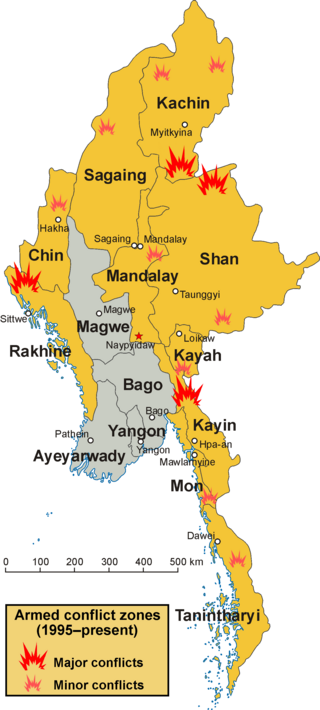
The Myanmar peace process refers to the nation led discussions aimed at relieving the internal armed conflict that has been simmering in Myanmar since before it gained independence from Britain in 1948. Many of the events that have taken place can be attributed to tensions surrounding the treatment of the numerous different ethnic minorities. This conflict involves both the Myanmar government and military, and the 16 armed ethnic minorities in Myanmar. In recent years tension between the Myanmar government and the military has been increasing, with the military still holding position as the most powerful political force in Myanmar.

General elections were held in Myanmar on 8 November 2020. Voting occurred in all constituencies, excluding seats appointed by or reserved for the military, to elect members to both the upper house — the Amyotha Hluttaw and the lower house — the Pyithu Hluttaw of the Assembly of the Union, as well as State and Regional Hluttaws (legislatures). Ethnic Affairs Ministers were also elected by their designated electorates on the same day, although only select ethnic minorities in particular states and regions were entitled to vote for them. A total of 1,171 national, state, and regional seats were contested in the election, with polling having taken place in all townships, including areas considered conflict zones and self-administered regions.
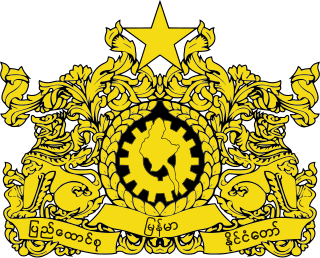
The National Convention was a constituent assembly formed by the State Law and Order Restoration Council of Myanmar, with the stated goal of establishing a new constitution for the country. Dominated by representatives of the SLORC, the National Convention was boycotted by members of the National League for Democracy and other members, who represented both elected members of parliament and ethnic minorities.








